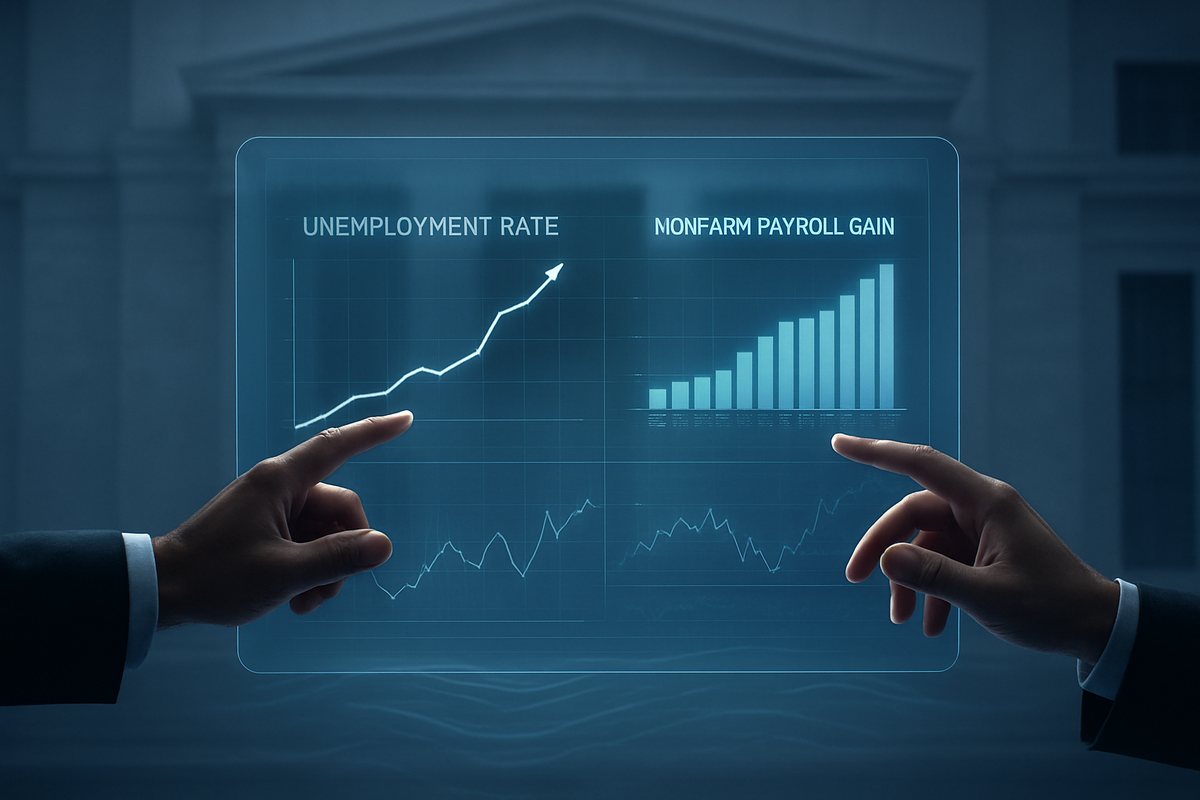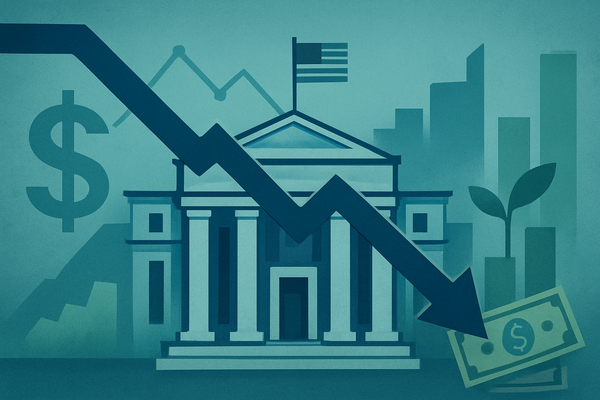September Jobs Report Ignites Fiery Fed Debate Over December Rate Cut

The U.S. labor market presented a perplexing and pivotal report in September 2025, revealing a stronger-than-expected nonfarm payroll gain that nonetheless coincided with an unwelcome rise in the unemployment rate. This intricate data tapestry, unveiled amidst the backdrop of a significant government shutdown and subsequent data delays, has intensified an already fervent debate within the Federal Reserve regarding the necessity and timing of a potential interest rate cut in December. As policymakers grapple with conflicting economic signals, the financial markets remain on tenterhooks, scrutinizing every pronouncement for clues about the Fed's next move.
The September Jobs Report, showing 119,000 nonfarm payrolls added and the unemployment rate climbing to a four-year high of 4.4%, has profoundly deepened the Federal Reserve's internal deliberations. This crucial economic data point arrived at a critical juncture, becoming the last comprehensive labor market update available to the Federal Open Market Committee (FOMC) before its pivotal December policy meeting. The mixed signals—robust job creation contrasting with an expanding pool of unemployed individuals—have armed both "hawks" advocating for higher rates to temper inflation and "doves" pushing for cuts to bolster the slowing economy, setting the stage for a contentious decision that will reverberate across the global financial landscape.
A Mixed Signal: Unpacking the September Jobs Report and the Fed's Dilemma
The September 2025 Jobs Report delivered a complex narrative for the U.S. economy. The headline figure revealed the addition of 119,000 nonfarm payrolls, a notable acceleration that surpassed economists' consensus forecasts and marked the strongest job gain in five months. However, this seemingly robust job growth was overshadowed by a concerning increase in the unemployment rate, which climbed to 4.4% from 4.3% in August, reaching a four-year high. Further complicating the picture, average hourly earnings grew by a modest 0.2% month-on-month, slowing from August's 0.4% rise and suggesting a deceleration in wage pressures. The labor force participation rate, however, offered a glimmer of positivity, inching up to 62.4%. Revisions to prior months' data also painted a less rosy picture, with July and August's combined employment figures revised down by 33,000. Sectorally, healthcare, food services, and social assistance saw significant gains, while transportation, manufacturing, and federal government employment experienced declines.
The path to this contentious debate has been marked by several key events. The Federal Reserve had already initiated two 25-basis-point interest rate cuts in September and October 2025, bringing the federal funds rate to a target range of 3.75%-4.00%. However, a protracted 43-day federal government shutdown significantly delayed the release of the September Jobs Report, pushing it back by over six weeks to November 20, 2025. This delay meant the October employment report was canceled, making the belated September data the sole comprehensive labor market update before the Fed's December 9-10 policy meeting. The minutes from the October FOMC meeting, released on November 19, 2025, explicitly highlighted "strongly differing views" among policymakers regarding a December rate cut, with some deeming it inappropriate while others argued for its justification.
Key players in this high-stakes economic drama include Federal Reserve officials, led by Chair Jerome Powell, whose statements and decisions are meticulously scrutinized. Regional Federal Reserve Presidents, such as New York Fed President John Williams, whose recent dovish remarks spurred market activity, and Governors like Michael Barr, Austan Goolsbee, and the notably dovish Stephen Miran, each contribute their unique economic perspectives to the FOMC's deliberations. The Bureau of Labor Statistics (BLS) provides the foundational data, while private sector economists and analysts from institutions like Capital Economics and Oxford Economics offer crucial interpretations. The CME Group's (CME) FedWatch Tool, which tracks federal funds futures, has become a real-time barometer of market expectations, showing significant volatility in rate cut probabilities.
Initial market reactions to the September Jobs Report on November 20, 2025, were characterized by a blend of uncertainty and cautious optimism. Equities initially saw the mixed data as potentially nudging the Fed towards a more dovish stance, with S&P futures bouncing back. U.S. stock markets edged up following the report, recovering some losses from earlier in the week attributed to diminishing rate cut expectations. The bond market, particularly U.S. Treasuries, reacted more strongly, surging on November 21st after New York Fed President John Williams' comments, causing the 10-year yield to fall nine basis points. The CME FedWatch Tool reflected this volatility; while the probability of a December rate cut had plummeted from nearly 94% a month prior to around 50% by mid-November, it ticked up to 40% immediately after the report and then surpassed 50% after Williams' remarks, underscoring the market's sensitivity to both economic data and central bank rhetoric.
Companies on the Cusp: Winners and Losers from the Fed's Decision
The Federal Reserve's impending decision on a December rate cut, heavily influenced by the September Jobs Report, carries significant implications for various sectors and public companies. A rate cut would generally be seen as a stimulus, lowering borrowing costs and potentially boosting economic activity, while a decision to hold rates steady or even hint at future hikes could dampen growth.
Companies that could benefit from a rate cut are typically those sensitive to interest rates and consumer spending. Housing-related companies would likely see a boost. Lower mortgage rates could stimulate demand for new homes, benefiting homebuilders like D.R. Horton (NYSE: DHI) and Lennar Corporation (NYSE: LEN), as well as home improvement retailers such as The Home Depot (NYSE: HD) and Lowe's Companies (NYSE: LOW). Similarly, financial institutions with significant mortgage lending operations, like Wells Fargo (NYSE: WFC) or JPMorgan Chase & Co. (NYSE: JPM), could see increased loan origination volume, although their net interest margins might be squeezed by lower rates. Consumer discretionary companies, such as Amazon.com (NASDAQ: AMZN) or Starbucks Corporation (NYSE: SBUX), could also benefit as lower borrowing costs for consumers might free up disposable income, encouraging spending. Technology companies (e.g., Apple Inc. (NASDAQ: AAPL), Microsoft Corporation (NASDAQ: MSFT)) often thrive in lower-rate environments as their future earnings are discounted less heavily, making their valuations more attractive.
Conversely, a decision by the Fed to hold rates steady or signal a hawkish stance would likely create headwinds for these same sectors. Higher borrowing costs could cool the housing market, reduce consumer spending, and make it more expensive for companies to finance expansion. Banks with significant deposit bases might see their net interest margins improve if rates remain elevated, but overall loan demand could soften. Utilities (e.g., NextEra Energy (NYSE: NEE)) and other dividend-paying stocks might face competition from higher-yielding bonds if rates remain high, making their dividends less attractive to income-focused investors. Companies with high debt loads would also face increased pressure from higher interest payments, potentially impacting their profitability and investment plans.
The September Jobs Report, with its mixed signals of job growth and rising unemployment, adds layers of complexity. If the Fed interprets the rising unemployment as a sign of economic weakening that necessitates a cut, the beneficiaries would be those sensitive to cheaper credit. However, if the strong payroll gains are prioritized, suggesting underlying economic resilience that could reignite inflation, the Fed might hold, creating a more challenging environment for growth-oriented stocks and those reliant on consumer credit. The market's current uncertainty reflects this binary outcome, with companies strategically positioning themselves for either scenario, often through debt management and capital allocation decisions.
Broader Implications: Navigating Economic Crosscurrents
The September Jobs Report and the subsequent Federal Reserve debate are not isolated events but rather integral components of broader economic trends, particularly concerning inflation and the health of the labor market. The persistent strength in nonfarm payrolls, even as unemployment ticks up, suggests a labor market that is simultaneously robust in job creation yet potentially softening in its ability to absorb all available workers. This "Goldilocks" scenario—not too hot to fuel inflation, not too cold to trigger a recession—is precisely what the Fed aims for, but the September data makes it harder to ascertain if that balance is being achieved. Lingering inflation concerns, despite some moderation, remain a significant hurdle for a decisive rate cut, as evidenced by the "strongly differing views" within the FOMC.
The ripple effects of the Fed's decision extend far beyond direct interest rate impacts. Competitors and partners across industries will be affected by shifts in consumer demand, corporate investment, and access to capital. For instance, if a rate cut stimulates the housing market, it could benefit building material suppliers and logistics companies, creating a positive ripple. Conversely, if rates remain high, it could stifle innovation and expansion for smaller businesses and startups that rely heavily on affordable credit, potentially widening the competitive gap with larger, more established players. Globally, the U.S. interest rate trajectory influences currency valuations and capital flows, impacting multinational corporations and emerging markets. A weaker dollar due to rate cuts could make U.S. exports more competitive but might increase import costs, affecting companies like Walmart (NYSE: WMT) and Target (NYSE: TGT) with extensive global supply chains.
From a regulatory and policy perspective, the Fed's dilemma highlights the challenges of monetary policy in a post-pandemic, high-debt environment. The explicit pressure from the White House, under President Donald Trump, for rate cuts adds a political dimension, potentially challenging the Fed's traditional independence. This situation echoes historical precedents where political influence or conflicting economic data created difficult choices for the central bank. For example, during the early 2000s, the Fed navigated similar mixed signals, trying to balance economic growth with inflation control, often leading to periods of market uncertainty and heightened speculation about future policy moves. The current scenario underscores the delicate balance the Fed must maintain to preserve its credibility while responding effectively to evolving economic conditions.
The delayed release of the September Jobs Report due to the government shutdown further complicated the policy landscape, leaving the Fed with less timely information. This operational disruption itself represents a policy challenge, as accurate and timely data are paramount for informed decision-making. The cumulative effect is an environment where the Fed's communication becomes even more critical, with every word from officials meticulously analyzed for hints about the future direction of monetary policy.
The Road Ahead: Scenarios and Strategic Adaptations
Looking ahead, the Federal Reserve's December meeting stands as a critical juncture, with several potential scenarios emerging from the September Jobs Report's mixed signals. In the short-term, the most immediate possibility is a 25-basis-point rate cut, especially if the Fed prioritizes the rising unemployment rate and the softening wage growth as indicators of a decelerating economy requiring stimulus. This scenario would likely be met with a positive market reaction, particularly in growth sectors and among companies sensitive to borrowing costs. Alternatively, the Fed could choose to hold rates steady, citing the robust nonfarm payroll gains and lingering inflation concerns, signaling a "wait-and-see" approach. This would likely cause some market disappointment but could be framed as a responsible move to ensure inflation is truly under control. A less likely but still possible scenario is a more aggressive 50-basis-point cut, particularly if upcoming economic data or geopolitical events point to a more severe slowdown.
In the long-term, the trajectory of interest rates will depend heavily on subsequent economic data, particularly the combined October/November jobs report due in mid-December, and inflation figures. If inflation continues to moderate and the labor market shows further signs of weakening, a series of rate cuts throughout 2026 could be on the horizon, aiming to achieve a "soft landing" for the economy. Conversely, if inflation proves stickier or the labor market rebounds strongly, the Fed might maintain a higher-for-longer stance, potentially even considering rate hikes if inflationary pressures resurface.
For businesses, these potential outcomes necessitate strategic pivots and adaptations. Companies with significant debt exposure should prioritize refinancing at lower rates if a cut occurs, or manage their debt aggressively if rates remain high. Technology firms and growth companies might accelerate investment plans in a lower-rate environment, while value-oriented companies may need to demonstrate strong fundamentals to attract investors if rates remain elevated. Financial institutions must prepare for both scenarios, adjusting their lending strategies and asset-liability management. Market opportunities may emerge in sectors poised to benefit from specific rate movements—e.g., real estate investment trusts (REITs) like Prologis (NYSE: PLG) could see renewed interest with lower borrowing costs, or defensive sectors like consumer staples (e.g., Procter & Gamble (NYSE: PG)) might gain favor in a higher-rate, uncertain environment. The key will be agility and a robust understanding of how interest rate changes translate into consumer behavior and corporate profitability.
Concluding Thoughts: A Pivotal Moment for the Market
The September Jobs Report has undeniably placed the Federal Reserve at a critical crossroads, amplifying the internal debate over a December rate cut. The report's dual message—strong nonfarm payroll gains countered by a rising unemployment rate—epitomizes the complex economic environment policymakers are navigating. Key takeaways include the significant impact of data delays on the Fed's decision-making process, the heightened sensitivity of financial markets to every utterance from central bankers, and the deep divisions within the FOMC itself. This is not merely a technical adjustment to interest rates; it is a fundamental assessment of the U.S. economy's underlying health and future trajectory.
Moving forward, the market remains highly reactive to incoming economic data and Fed communications. Investors should prepare for continued volatility as the December FOMC meeting approaches. The assessment of the market's direction hinges on whether the Fed ultimately prioritizes the signs of labor market softening (rising unemployment, slowing wage growth) or the resilience of job creation. A rate cut would likely inject optimism, potentially fueling a year-end rally, while a hold could introduce a period of consolidation or even correction as markets adjust to a less accommodative stance.
The lasting impact of this debate will be on the Fed's credibility and its ability to steer the economy toward a soft landing without reigniting inflation. What investors should watch for in the coming months are not only the official Fed announcements but also the nuances in speeches from individual governors, the upcoming combined October/November jobs report, and crucial inflation data. Understanding the Fed's interpretive framework—how it weighs conflicting economic signals—will be paramount. This period underscores the adage that in financial markets, information is power, and clarity from the central bank is the most valuable commodity.
This content is intended for informational purposes only and is not financial advice



